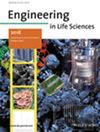Production of Bioproducts from Wastewater Treatment Using the Microalga Neochloris oleoabundans
Abstract
Olive mill wastewater (OMW) poses an environmental risk due to its high chemical oxygen demand (COD). It is also rich in nutrients and organic carbon and has been used in this study together with urban wastewater (UWW) as part of the Neochloris oleoabundans culture medium in different proportions to analyze the results in the change of proportion in the mixtures, looking for the highest level of wastewater utilization. The objective was to determine both the growth capacity of the microorganism in this medium for subsequent production of bioproducts (such as pigments, crude protein, or lipids) from the generated microalgal biomass, as well as the rate of removal of compounds present in wastewater after treatment, which enables it to be discharged into public canals and used for irrigation. The bioprocesses which were developed in batch photobioreactors of 1 dm3, showed the highest values of maximum specific growth rate and volumetric biomass productivity 0.082 h−1 and 3 mg dm−3 h−1, respectively. The maximum percentage of crude proteins (49.5%), lipids (51.0%), and carbohydrates (56.0%) we obtained in the final biomass. In this regard, the biggest percentages of organic load removal in the treatment with N. oleoabundans were 65.66% for total phenolic compounds and 93.7% for COD. In addition, the potential content of salts such as nitrates, nitrites, and orthophosphate decreased for 97.6%, 94.3%, and 69.2%, respectively. Values that show the suitability of N. oleoabundans for the recovery of bioproducts and the reduction of the pollutant load of wastewater for its reuse in agriculture, increasing the circular bioeconomy in the olive sector.
Summary
-
In a region with the highest olive oil production in the world, the high generation of waste from the olive oil industry requires the implementation of solutions to valorize and minimize the waste generated. The treatment of olive mill wastewater, used as a culture medium providing nutrients for the development of microalgae, is a promising procedure.
-
In this study, the microalgae Neochloris oleoabundans has been used to treat olive oil mill wastewater, which has allowed high yields to be obtained in the production of biomass that can be transformed into bioproducts such as carbohydrates, proteins, and lipids. In addition, a high yield is obtained in the elimination of components that can be harmful, which is relevant for the reuse of water for irrigation or for discharge into natural watercourses.
-
The experimental results of this work have also considered the ability of N. oleoabundans to purify urban wastewater from secondary wastewater treatment.





 求助内容:
求助内容: 应助结果提醒方式:
应助结果提醒方式:


